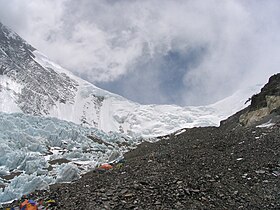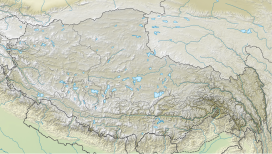
Back Şimal Aşırımı Azerbaijani Sjeverni prijevoj BS Collada Nord (Everest) Catalan Everest North Col CEB کۆلی باکوور CKB Collado Norte Spanish Põhjasadul Estonian Chang Lan sola Finnish Col Nord French उत्तर कोल Hindi
| North Col | |
|---|---|
 Mount Everest. The North Col is the lowest point of the snowy ridge in the middle. | |
| Elevation | 7,020 m (23,031 ft) |
| Traversed by | George Mallory, Edward Oliver Wheeler and Guy Bullock (1921) |
| Location | China (Tibet) |
| Range | Mahalangur Himal |
| Coordinates | 28°00′57″N 86°55′30″E / 28.01583°N 86.92500°E |
The North Col (Chinese: 北坳; pinyin: Běi Ào; Tibetan: Chang La) refers to the sharp-edged pass carved by glaciers in the ridge connecting Mount Everest and Changtse in Tibet. It forms the head of the East Rongbuk Glacier.
When climbers attempt to climb Everest via the North Ridge (Tibet), the first camp on the mountain itself (traditional Camp IV, modern Camp I) is established on the North Col. From this point at approximately 7,020 metres (23,030 ft) above sea level, climbers ascend the North Ridge to reach a series of progressively higher camps along the North Face of Everest. Climbers make their final push to the summit from Camp VI at 8,230 metres (27,001 ft) altitude.[1]
The North Col was first climbed by George Mallory, Edward Oliver Wheeler, and Guy Bullock on 24 September 1921, during the British reconnaissance expedition. This was the first time a Westerner had set foot on Mount Everest. Although long credited to Mallory, discovery of the North Col was in fact made by Wheeler about a week before Mallory confirmed its existence while searching for possible routes to the summit of Mount Everest. All subsequent expeditions in the 1920s and 1930s attempted to reach the summit of Everest by using the North Col.[2]
Before 1950, most Everest expeditions went from Tibet and via the North Col, but most now go from Nepal via the South Col. In 1951, two mountaineers on the 1952 British Cho Oyu expedition, Edmund Hillary and George Lowe, crossed the Nup La Col, and "like a couple of naughty schoolboys" went deep into Chinese territory, down to Rongbuk and round to the old prewar Camp III beneath the North Col.[3]



- ^ "North Col of Mount Everest". NASA.
- ^ Peter Gillman, ed. (1993). Everest - The Best Writing and Pictures from Seventy Years of Human Endeavour. Little, Brown and Company. pp. 24–25. ISBN 0-316-90489-9.
- ^ George Lowe and Huw Lewis-Jones, The Conquest of Everest: Original Photographs from the Legendary First Ascent (London: Thames and Hudson, 2013) (pages 23,212) ISBN 978-0-500-54423-5

